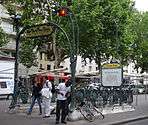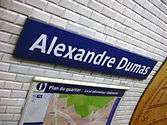Alexandre Dumas (Paris Métro)
Alexandre Dumas ([alɛksɑ̃dʁ dymɑ]) is a station on Paris Métro Line 2, on the border of the 11th and 20th arrondissements.
| Paris Métro station | |||||||||||
 | |||||||||||
| Location | 111, boul. de Charonne 11th arrondissement of Paris Île-de-France France | ||||||||||
| Coordinates | 48°51′21″N 2°23′41″E | ||||||||||
| Owned by | RATP | ||||||||||
| Operated by | RATP | ||||||||||
| Other information | |||||||||||
| Fare zone | 1 | ||||||||||
| History | |||||||||||
| Opened | 31 January 1903 | ||||||||||
| Previous names | Bagnolet (1903–1970) | ||||||||||
| Services | |||||||||||
| |||||||||||
| Location | |||||||||||
 Alexandre Dumas Location within Paris | |||||||||||
Location
The station is located under Boulevard de Charonne at its intersection with Rue de Charonne and Rue de Bagnolet. Oriented approximately along a north-west / south-east axis, it is located between the Philippe Auguste and Avron metro stations.
History
The station was opened on 31 January 1903 as part of the extension of line 2 (known at the time as "2 Nord") from Anvers. It was the eastern terminus of the line until 2 April 1903 when it was extended to Nation. The station was originally called Bagnolet after the Rue de Bagnolet, the road to Bagnolet. On 13 September 1970, it was renamed after the French author Alexandre Dumas and the Rue Alexandre Dumas. It was the location of the Barrière de Fontarabie, a gate built for the collection of taxation as part of the Wall of the Farmers-General; the gate was built between 1784 and 1788 and demolished during the nineteenth century.[1][2]
As part of the RATP Metro Renewal program, the station corridors and platform lighting were renovated on 12 May 2005.[3]
On 1 April 2016, some of the station's name plates were temporarily replaced by the RATP to produce April Fools jokes for a day, as in the case of twelve other stations.[4] Alexandre Dumas was humorously renamed Les Trois Mousquetaires (The Three Musketeers) in reference to the famous novel by this writer.
As part of the action plan in 2018 to improve air quality in the metro, the station was the first in which two air purifiers were tested using an Ip'Air device developed by Suez. They were inaugurated on 7 June 2019 on the platform in the direction of Nation and set up for a period of six months.[5]
In 2019, 3,439,879 travelers entered this station which placed it at the 142nd position of the metro stations for its usage.[6]
Passenger services
Access
The station has a single exit entitled Boulevard de Charonne, leading to the central reservation of the boulevard to the right of No. 111. Consisting of a fixed staircase, it is decorated with a Guimard entrance, which is subject to a registration as historic monuments by decree of 12 February 2016.[7]
Station layout
| Street Level |
| B1 | Mezzanine for platform connection |
| Platform level | Side platform, doors will open on the right | |
| Platform 1 | ← | |
| Platform 2 | | |
| Side platform, doors will open on the right | ||
Platforms
Alexandre Dumas is a standard configuration station. It has two platforms separated by the metro tracks and the vault is elliptical. The decoration is the style used for most metro stations, the lighting canopies are white and rounded in the Gaudin style of the metro revival of the 2000s, and the bevelled white ceramic tiles cover the walls, the vault, the tympans and the outlets of the corridors. The advertising frames are metallic and the name of the station is written in Parisine font on enameled plates. The seats are dark blue Motte style (replacing yellow seats of the same original model).
Bus connections
The station is served by line 76 of the RATP Bus Network.
Gallery
 Street-level entrance to station platforms
Street-level entrance to station platforms Station signage
Station signage
References
- "Barrière de Fontarabie, picture" (in French). Bibliothèque nationale de France. Retrieved 14 October 2009.
- "Barrière de Fontarabie" (in French). Bibliothèque nationale de France. Retrieved 14 October 2009.
- "SYMBIOZ - Le Renouveau du Métro". www.symbioz.net. Retrieved 16 May 2020.
- "EN IMAGES. Poisson d'avril : la RATP rebaptise ses stations". leparisien.fr (in French). 1 April 2016. Retrieved 15 May 2020.
- Desmonceaux, Juliette (7 June 2019). "Comment la RATP veut purifier l'air du métro à Paris". www.20minutes.fr (in French). Retrieved 16 May 2020.
- "Trafic annuel entrant par station du réseau ferré 2019". data.ratp.fr (in French). Retrieved 16 May 2020.
- "Métropolitain, station Alexandre-Dumas". www.pop.culture.gouv.fr. Retrieved 16 May 2020.
| Wikimedia Commons has media related to Alexandre Dumas (Paris Metro). |
- Sources
- Roland, Gérard (2003). Stations de métro. D’Abbesses à Wagram. Éditions Bonneton.